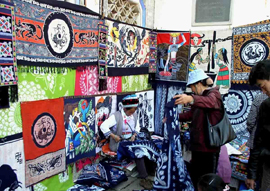Dali" in Chinese means "marble" because it is the home of marble. Dali is a city 400 km west of Kunming. It is located between the Erhai Lake and the Cangshan Mountain. The Cangshan Mountain with 19 peaks stands here like a silver screen.
The highest peak is 4120 meters above sea level and the whole mountain range runs as long as 50km. The Erhai Lake looks like a mirror dotted with floating boats on its rippling surface.
The Erhai Park on the southern shore provides visitors with its ancient-style pavilions corridors and platforms where one can take a panoramic view of the Cangshan Mountain and the Erhai Lake. The Butterfly Spring is another frequent destination of tourist in Dali. The clear water and the flying butterflies give people a sense of  tranquility and mystery. tranquility and mystery.
Dali is noted for its glorious history and culture. Built in the 9th century the three majestic pagoda of Cangshan Temple present a typical architectural style of ancient China. The stone Dehua Tablet of Nanzhao Kingdom is a very important historical relic for searching the history of the Tang Dynasty and the Nanzhao Kingdom. Another important historical relic is the Stone Tablet Commemorating Kublai Khan's Conquest of Yunnan. This tablet is the earliest record about the establishment of Yuannan Province by Kublai Khan.
In history Dali used to be one of the important posts on the road to india and Myanmar. It was once a very prosperous town for cultural and economic exchanges between China and Southeast Asian countries. Both the well£known Chinese geographer Xu Xiake and the italian traveler Marco Polo visited Dali and described it in their travels.
Today Constructions in Dali are scattered in a chessboard-like fashion. Part of the city walls is perfectly preserved. The roads are paved with gray flagstone. The local dwelling houses are typical of the architecture of the ethnic Bai group.
Attractions in Dali: Butterfly Spring Three Pagodas |
